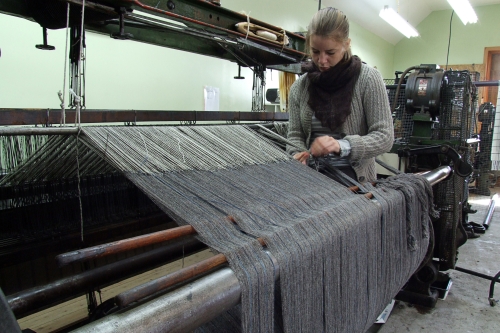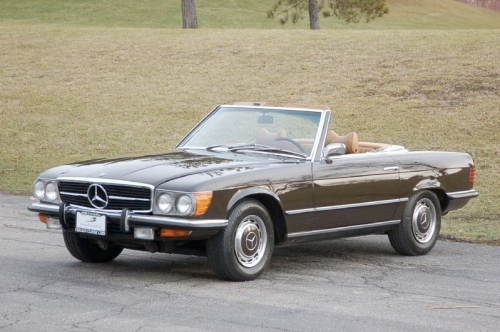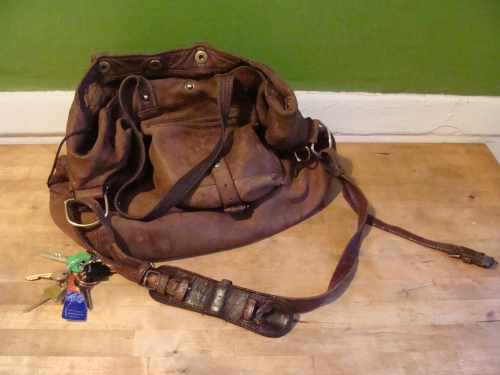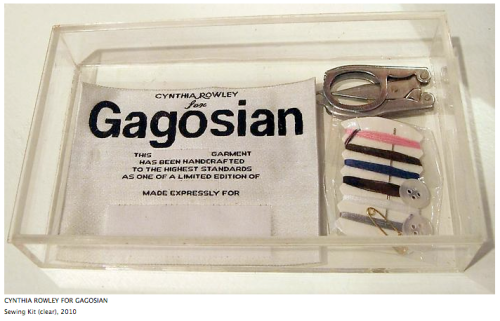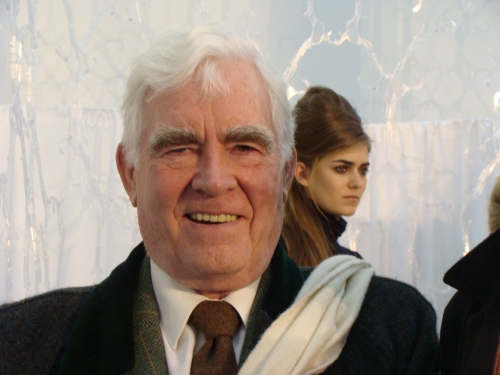Last night at the Loomstate party, I told someone I was a journalist.
“Who do you work for?” he asked.
“I’m independent,” I replied, which is funny, because in many ways, nothing could be further from the truth. Sure, my stories are my own and I have no editor to answer to, but lately I get overwhelmed thinking about everyone pitching in to help me with the completion of a website about sustainable style, based on my recent trip to Sweden.
I’ll limit my example to yesterday alone. I’ve asked two of the Swedish designers I’m writing about for additional photographs for the site. One simply sent me a login to peruse her server as I pleased, and the other emailed me selected favorites, including the one below, of her colleague weaving wool in Scotland. I tend to have my Sweden emails in the morning, thanks to the time difference, and these were particularly lovely to wake up to.
But it was time to get down to business. One of my mounting challenges in writing about sustainability, as I’ve noted, is the tremendous task of defining the word. Recently, a Huffington Post reader called Denis Ethier alerted me on Twitter (I get it now!) that he had just left a comment under my article. Indeed, dear Denis had advised me that in using the term “sustainable growth,” I had employed an oxymoron, and directed me to Dr. Albert Bartlett’s Laws of Sustainability.
Dr. Bartlett, who holds a PhD in Nuclear Physics from Harvard, has been writing and lecturing about sustainability for forty years, and I found his papers to be at once helpful and harrowing.

“The greatest shortcoming of the human race,” Dr. Bartlett once famously said, “is our inability to understand the exponential function.” (That’s the green one.) I was experiencing an inability to understand a great number of things, but I was able to perceive an exponentially increasing portion of panic. So I did what any perplexed fashion enthusiast would do, and directly contacted a nuclear physicist. Within moments Dr. Bartlett replied to my email, with his home telephone number and a warning he knew nothing “about fashions.” We had an enlightening chat, which you’ll be able to read about once the Sweden site is done.
New Source: Dr. Al Bartlett
By the time we said goodbye, Loomstate’s Earth Day party was about to begin. Commemorating Earth Day in a basement beneath midtown seemed a little counterintuitive until I walked into the sprawling room and saw Pemba Sherpa, one of my absolute favorite souls on this planet. Edun, my previous employer, was once housed in the same SoHo apartment as fashion brands Rogan and Loomstate. Things have since grown and separated a bit (exponentially? I’m not sure.), and Pemba remains the single employee all three labels share. This speaks to their intelligence, because any place blessed with Pemba’s presence on a daily basis will find their employees learning daily lessons about patient kindness from his example.
 Old Friend: Pemba Sherpa (on my last day at Edun)
Old Friend: Pemba Sherpa (on my last day at Edun)
He used to be a guide in the Himalayas (now he treks between Edun, Rogan and Loomstate’s Tribeca offices, handling all things logistical), so Pemba’s appreciation for the planet comes from a uniquely elevated perspective. He knows I love stories from his native Nepal, and he recently returned, but this time his most exciting revelation was not about the mountains, but about an unplanned pregnancy in his community, which resulted in an unplanned adoption, and now Pemba is the proud papa of Arbin Tshering Dorjee Sherpa. I thought of Dr. Bartlett’s famous lecture on population growth, and how heartily he might approve of Pemba’s adoption strategy. It also occurred to me that if I’m ever reborn, Pemba’s family might be a good one to go for.
Just then, 40 drummers filed in, and took their seats at a mishmash of sets under a white pyramid in the center of the cavernous space. Cymbals began to shimmer. A pelican in slow-motion flight was projected onto the pyramid; and Pemba stood beside me, taking pictures. Before long, a strong reverberation took over the room, and it became nearly impossible to distinguish between the beats of the different drummers. Before they started playing Scott Hahn had introduced the program saying they intended to “shatter the illusion that we’re all separate.” Indeed.
When I got home, I checked my email, and found a message from a reader who had sent a question about organic concert tee shirts a few weeks ago. We’ve never met in person, but he asked if I had been at the Loomstate party, and then later on the L-train! He had recognized me from those seemingly gratuitous photos I post of myself, and even asked if I was free tonight, as he’s found himself with an extra ticket to the opera. I loved the idea of meeting up for the opera, but am previously engaged for a pow-wow with the Sweden site’s new designer/developer –a young lady called Grace, whose surname, incidentally, is derived from the German for one who weaves.

